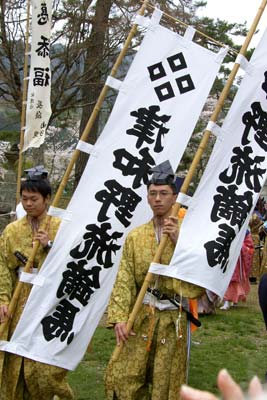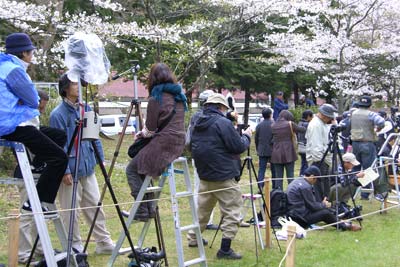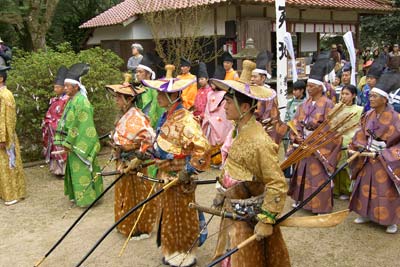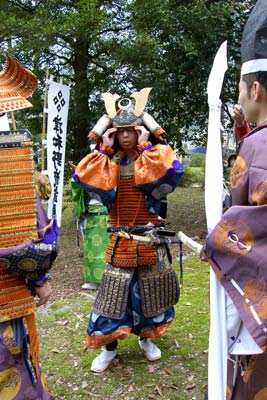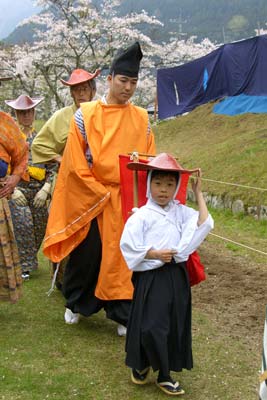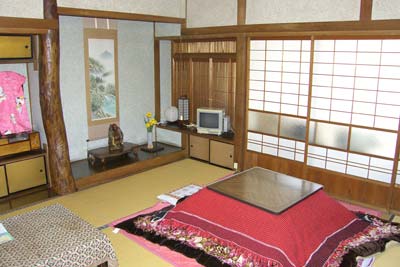Witnessing the ancient yabusame ceremony in Tsuwano, Japan
by Clyde Holt, Hinesburg, VT, photos by Clyde and Jane Holt
Tsuwano, in Japan’s Shimane Prefecture in western Honshu, is a small mountain town with the faint remains of a ruined castle, two Shinto shrines, a street of restored samurai houses, and a chapel memorializing Catholics martyred there in the last period of the persecution of Christians in Japan. It is a pretty, quiet little town, often visited by day-tripping Japanese tour groups from nearby Yamaguchi, the capital of the adjacent Yamaguchi prefecture.
It is also visited by travelers from Hagi on the north coast, although Hagi has plenty of sights of its own, and from Iwakuni on the south coast, which has a restored samurai quarter, a reconstructed castle and the famous Brocade Sash Bridge (Kintai-kyo). For all of these tourists, Tsuwano has enough attractions for a day trip.
We spent three days in Tsuwano in April ’08, but we didn’t go for the sights. We went for the yabusame, a ceremony of horseback archery practiced on the only remaining original yabusame course in Japan.
Making arrangements
Access to Tsuwano was easy. Using our 21-day Japan Rail Passes (¥57,700, or about $534, for an ordinary pass) purchased from JALPAK International in New York (888/352-5725, www.jalpak.com), we traveled from Iwakuni via Yamaguchi.
We were able to choose our route and our schedule easily by accessing the Japan Rail website and going through their Quick Search option to Hyperdia (www.japanrail.com/JR_hyperdia.html), a self-explanatory search engine. Just enter a town of departure, a town of arrival and an approximate hour of travel and it provides travel times, train changes, prices and all relevant options.
Finding accommodations in Tsuwano is easy, too. There is one hotel in the center of town and others on the outskirts, plus a surprising number of Japanese inns (ryokans and minshukus). Apparently, Tsuwano is not just a day-tripper’s town; it’s a destination for summer weekends in the hills.
Several of the ryokans are quite fancy, their prices reflecting their quality. Many are in the center of town, within a 10-minute walk of the train station.
We chose an inexpensive inn, the Hoshi Ryokan, partly on the basis of price but mostly because it was the lodging nearest to the train station, no more than a 3-minute walk away. As with a great many Japanese ryokans, we had to make arrangements by fax (011 81 08567 2 0241); for some reason, the Internet and e-mail have not yet taken hold in the Japanese hotel industry.
We signed up for a double room and were surprised to be given two large rooms separated by a sliding shoji screen, allowing our futons to be left set up all day. The price per person per night with breakfast was ¥5,800, or about $58. Dinner could be included in the room price for a total of ¥7,000 ($64).
Finding the website for the Hoshi Ryokan (listed as Tsuwano Star Hotel) was a bit tricky, as it is with many small Japanese hotels whose websites exist only in Japanese. Rather than directly visiting the site, (www.iwami.or.jp/dai/school/yado.htm), enter the URL into the Google search bar. This will bring up the entry in Japanese. Click “Translate this page” to get a passable English translation.
Note that the prices are somewhat outdated; be sure to verify the price when you make a reservation by fax. The phone number is incorrect on the website; the correct number is 011 81 08567 2 0136.
The inn experience
Many ryokans are run by a mother-and-daughter (or -daughter-in-law) team, as was the case at the Hoshi Ryokan. The mother spoke no English, but the daughter, who also claimed not to know English, in fact turned out to be perfectly conversant. With patience and an occasional rephrasing of our questions, we were able to communicate with her easily. In any case, she spoke a whole heck of a lot more English than we speak Japanese, to our undying shame.
We wanted to sample the restaurants of Tsuwano that we’d found on the Internet, so we opted to have only breakfast at the inn. This proved to be a mistake on several counts. We couldn’t find many of the restaurants on our list, and others had gone out of business. Those we did find were adequate but not special, and communication was difficult.
On the other hand, when finally we chose to have dinner at the ryokan, we were presented with a remarkable spread of excellent food. It was clear why ryokans have the reputation for producing fine meals and why most travelers dine in.
Tsuwano sights
Tsuwano is a pretty sophisticated little place; it just hasn’t caught up with the end of the 20th century yet, much less the 21st. This castle town has a long block of old samurai buildings, tarted up to a degree of cleanliness that makes it sufficiently antiseptic for the tour bus groups that come in waves to see the town.
The castle was destroyed after the Meiji restoration, but Tsuwano has a major Inari shrine, Taikodani-Inari-jinja, with rows and rows of torii (although much smaller than the ones at Fushimi Inari in Kyoto) climbing a steep hill. Somewhere up in the hills is a shrine to Christians martyred at a time when Christianity was illegal in Japan.
The canals of the town are supposed to have been filled with thousands upon thousands of koi, said to have been put there originally as a potential food source in anticipation of a siege. In truth, this proves to be tourist hype. There is a lot of mountain water rushing noisily through the town in deep concrete channels, but it’s far too fast for these decorative carp.
In a very few places, particularly around the slow samurai moats, there are quite a lot of gigantic carp in the most amazing colors, maybe the survivors of the siege that never came.
Understanding yabusame
The annual horseback archery ceremony, yabusame, is held several kilometers outside the center of town on the grounds of the Washibara Hachiman-gu shrine, which has what is said to be the last original yabusame course in Japan.
A yabusame course is a pretty simple thing. There’s a straight path a couple of hundred yards long for the horses to run on. Along one side is a berm about eight feet high which serves as a backstop for the arrows.
Horsemen (and a few horsewomen) dressed in Kamakura-period costumes ride like blue blazes down the course yelling the most alarming war cries. They control their mounts only with their legs; their hands are busy nocking blunt-headed arrows and firing them at the targets.
Obviously, this business of shooting arrows from atop 1,200 pounds of speeding horse is not some trivial “Hey, guys, let’s put on a show!” whimsy. It is, in fact, part of a tradition dating to the sixth century.
The riders are not merely honing their skills as warriors, either. Their success at hitting targets (which are supposed to symbolize three ancient Korean countries, of all things) is taken as a marker of how good the harvest will be for the year and how well the world will run. Nor is it merely an exercise in horseback archery. In the manner of Eastern martial arts, as much attention is paid to mental discipline and religious transcendence as to riding and shooting.
The ceremony at Tsuwano is carried out by members of the Ogasawara School, one of the two principal schools codified by the 12th century. Order is kept by men and women standing about in Kamakura costume, with contemporary windbreakers thrown on against the chill.
The experience
Our first few exposures to the event were pretty much a sensory shock — all terrifying yells and thundering hooves, and then something really, really big would hurtle by involving, perhaps, a man in a bizarre getup — but it’s all over before you can draw a breath.
As we got accustomed to it, though, we began to appreciate the Zen-like union of man and animal engaged in this warlike endeavor. (We also sympathized with the poor devil who couldn’t get the damned arrow to seat properly on the bowstring while a bazillion pounds of raw energy propelled him right past the target.)
I tried to imagine what it would be like to be up on one of those beasts, trying to bring off what is, at heart, a dry run for a bloodthirsty act: sticking an arrow into another guy’s gut before he sticks one into yours.
This being Japan, blood lust is combined with beauty. The entire course was lined with cherry trees whose blossoms had just achieved their final perfection, threatening to begin to shed.
Tsuwano’s yabusame is held on the second Sunday in April (never mind if your Lonely Planet says the second of every April), which means it will be held sometime from the eighth through the 14th — at the peak of the blossoms in this mountain town.
A horseman rockets down the course and amazingly hits a target, shivering the plank, and the crowd lets loose with a great “Hey!” Between horses, the breeze comes up and there’s a blizzard of delicate petals, the crowd exhaling a communal “Ooooh!”
Keep in mind, this really is a Shinto ceremony, though I suspect most of the spectators pay no attention to that. Before the riding, the horsemen and their retainers, an assortment of grooms, pages and soldiers all in full Edo kit, parade to the shrine. The horsemen and important officials enter the shrine for a service, while the lesser ranks stand at attention (for a very long time) outside. Then the horsemen and officials emerge and everyone parades to the end of the yabusame course, where the mounts await.
The course is blessed by a Shinto priest before the horsemen mount and parade solemnly down the length of the course to the start. And then all hell breaks loose.
Part of the crowd
There were so many spectators at the event that it was sometimes unpleasant, especially when we couldn’t take photographs easily because so many other photographers kept getting in the way. There were rope lines defining the running path and another line meant to hold the crowds well back to avoid spooking the horses.
This being a nation of photographers — not to mention all the gaijin (foreigners) hoping to capture the event on film — everyone was trying to find the best angle, pressing against the rope and getting in each other’s way.
Luckily, a shopkeeper in town had alerted Jane and me to the possibility of going to the dress rehearsal the day before, where we were able to have most of the excitement and none of the crowds.
We were surprised by the number of young Americans in attendance. Apparently, a whole lot of young Americans have discovered they can get jobs in Japan teaching conversational English. Aficionados of all things Japanese, they turn up at events like this.
Though things were sometimes unpleasant at the morning running of the yabusame, they were a little better at the afternoon event. To begin with, the weather had grayed up a bit and there were spits of rain, discouraging spectators. New people arrived, of course, and quite a number of us oldsters stuck around, buying lunch from the booths set up just outside the grounds.
Most of the photographers were less frantic, and we settled pretty comfortably at the ropes.
After the event, the town tourism bureau laid on a dance festival on the stage off to the side of the shrine, and we were able to watch a considerable hunk of kagura, a theatrical Shinto dance.
It was a worthwhile stay.


